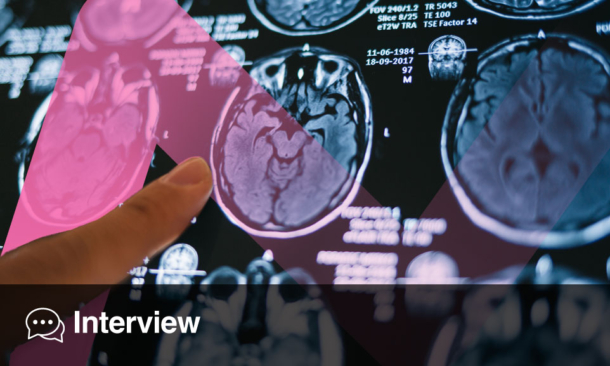VIENNA was the virtual home of the 7th Congress of the European Academy of Neurology (EAN), taking place from 19th to 22nd June. In what is the second year in a virtual setting, Claudio Bassetti, President of the EAN, welcomed the attendees by highlighting the vision of the EAN to be the voice of neurology in Europe, with its mission to reduce the burden of neurological and brain diseases. Bassetti highlighted the impact of neurological conditions as the third most common cause of death and disability in Europe.
In his introductory remarks on COVID-19, Bassetti highlighted the high variability in the levels of care and vaccination in countries around the world, and emphasised the importance of collaboration among partners and the importance of encouraging resilience and making care people-centric. Bassetti also highlighted the importance of digitalisation and data sharing as key elements in fighting COVID-19. “We have learnt that the health, social, [and] economic structures are interdependent and that these systems must work in a dynamic and systematic approach to solve the problem,” Bassetti outlined when discussing the lessons learnt from the COVID-19 pandemic.
It was exciting to hear about the activities of the EAN, especially the EAN Science School, which is devoted to bridging the gap between basic science and clinical medicine. The first School, taking place in March 2021, focused on a number of topics including immune neurological disorders, stroke, and epilepsy. Bassetti also highlighted the neuro-COVID-19 research initiative comprising a group of people from 34 sites collecting data to shed light on manifestations and complications of COVID-19. It is worth mentioning that the EAN has published an impressive set of data since it started: 107 guidelines, with 7 very new guidelines and 22 more in the pipeline.
This year’s EAN virtual platform introduced a live TV channel, live interactive sessions, networking areas, translation in Spanish and Russian, and many sessions around the clock with partners outside Europe, e.g., the Academies of Neurology of Brazil and India. This year’s plenary session covered the overarching theme of precision neurology, and the President’s Symposium covered the future of sleep medicine. With almost 12,000 attendees taking part and a high number of presented abstracts, the congress offered a plethora of highly engaging sessions. In this issue of EMJ Neurology we have covered a session on chrononeurology and rhythmicity in primary headache disorders.
The viewers of the opening ceremony also had the pleasure of watching the opening lecture, given by Jürgen Knoblich, Director of the Institute of Molecular Biotechnology, Vienna, Austria, who introduced the concept of cerebral organoids and how development of the human brain can be modelled in 3D cell cultures, giving an insight into potential future practices of neurology.
Like every other year, the opening ceremony was not complete without the honorary membership awards. Günther Deuschl, Professor of Neurology, Christian-Albrechts University Kiel, Germany, was the first recipient; among his numerous achievements, Deuschl is the founding president of the EAN, author of over 700 original publications, and among the top 1% of scientists worldwide. Bassetti hailed Deuschl as a pioneer in diagnostic and pathophysiological studies on tremor, who changed the way we look at deep brain stimulation in Parkinson’s disease. Phillip Scheltens, Professor of Cognitive Neurology and Director of Alzheimer Centre, VU University Medical Centre Amsterdam, the Netherlands, was the second recipient, in recognition of his work on dementia and Alzheimer’s disease and particularly for his work on early biomarkers of Alzheimer’s disease. Upon acceptance of his award and reflecting on the evolution of the field from barely being an area of neurology to the first approved treatment for Alzheimer’s disease, Scheltens expressed his belief that “This is only the beginning of finding treatments for Alzheimer’s disease.”
Plans are already in place for the 8th EAN Congress in 2022, which will again take place in Vienna. The plans for next year’s Presidential Symposium have already been made, with speakers from Sweden, Austria, the UK, and USA already having been confirmed. The key theme of next year’s congress will be translating evidence into practice, with a plenary symposium on improving lives and reducing disease burden.
Headache Highlights from EAN 2021 Presentations
ON DAY 4 of this year’s EAN 2021, Peter Goadsby, Professor of Neurology, King’s College London, UK, summarised highlights from the headache presentations, with a focus on the variety of new preventative and acute migraine therapies.
Goadsby drew the audience’s attention to a randomised, double-blind, placebo-controlled study designed to assess the efficacy and consistency of lasmiditan over four migraine attacks. Patients were randomised to one of three treatment groups: lasmiditan 200 mg, lasmiditan 100 mg, or a control group that received placebo for three attacks and lasmiditan 50 mg for either the third or fourth attack. The incidence of treatment-related adverse events was highest during the first attack. The most common adverse events included dizziness, paresthesia, and fatigue, which were typically mild or moderate in severity. In addition, both of the primary endpoints (pain freedom at 2 hours [first attack] and pain freedom at 2 hours in at least two of three migraine attacks) were met for lasmiditan. Similarly, all gated secondary endpoints, such as pain relief, disability freedom, and sustained pain freedom, were met. Overall, these results indicate the efficacy of lasmiditan.
In terms of monoclonal antibody therapy, Goadsby summarised the 5-year data for erenumab. Three hundred and eighty-three patients initially treated in a placebo-controlled trial were entered into an open-label extension phase. At 5 years, there were 214 patients who had completed the study. In total, 71% of patients reported a ≥50% reduction in mean monthly migraine days, 47% of patients reported a ≥75% reduction, and 36% of patients reported a ≥100% reduction. Eptinezumab, a calcitonin gene-related peptide monoclonal antibody, has also been shown to effectively prevent migraines. Patients were randomly assigned to receive either eptinezumab (n=238; 100 mg administered intravenously) or placebo (n=242) for treatment of an acute attack. At 2 hours after infusion, headache pain freedom was achieved by 23.5% of patients receiving eptinezumab and 12.0% of patients given the placebo (p=0.0009). Furthermore, the absence of most bothersome symptoms was achieved by 55.0% of eptinezumab-treated individuals and 35.8% of placebo patients (p=0.0001).
In conclusion, Goadsby emphasised that this was an exciting time to be a headache specialist because of the recent advances in safe and effective migraine treatment.
Migraine in Pregnancy at High Risk of Complications
CONCERNING the development of obstetric and post-partum complications, research in Israel led by Nirit Lev, shared at EAN 2021, has found that pregnant women who experience migraines are at increased health risk. Affecting mostly individuals of reproductive age, and one of the most prevalent disabling neurological disorders worldwide, the study aimed to evaluate the characteristics of this relationship and identify medical needs to direct action.
Between 2014 and 2020, the study analysed the pregnancies of 145,102 females, investigating mode of delivery, medical and obstetric complications, and the use of medication throughout. Within this population, 12,222 experienced migraine, of which 1,576 were migraine with aura. Findings included increased risk scores for pregnant migraine patients relating to gestational diagnosis of diabetes, hyperlipidaemia, and blood clot. Higher rates of epidural anaesthesia were also noted during the labour of females with migraine; however, this category was not particularly at risk of assisted delivery.
Lev commented: “Our study confirms that women who suffer from migraine are at a greater risk of a host of medical and obstetric complications. As such, we recommend that these women should be classed as ‘high-risk’ pregnancies and should therefore be treated according to a high-risk protocol,” drawing these conclusions based on their data, which highlight a 6.9% increased risk of admittance to ‘high-risk’ departments in those with migraine, and 8.7% in those with both migraine and aura.
The main action point this study hopes to convey, and provoke future action upon, is a provision of special monitoring and care throughout pregnancy in migraine-affected individuals; in the same way as would take place in those affected by diabetes, epilepsy, or high-blood pressure. In addition to this, “Migraine sufferers were also found to have a greater risk of developing depression during their pregnancy and after giving birth,” explained Levi, recommending a focus for any upcoming long-term initiatives. “As a result, they should also be offered a neurological consultation during pregnancy and adequate follow-up support after giving birth.” Future studies should build on these important conclusions, and also incorporate observation of the hormonal changes related to menstruation, menopause, and childbirth exhibiting effects to worsen migraine activity.
Treating Fatigue and Other Conditions in Multiple Sclerosis
FATIGUE is one of the most common yet understudied symptoms in multiple sclerosis (MS). Christian Enzinger from the EAN Organising Committee shared the presentations and studies he found most inspiring relating to fatigue and other conditions in MS at EAN 2021.
A new paper aimed to measure the impacts of fatigue in patients with MS using a novel disease-specific scale called FSIQ-RMS. The study is still in progress, but initial findings show that fatigue is one of the most reported symptoms that cause impactful disruption on a day-to-day basis in patients with MS. Thus far, the results demonstrate that FSIQ-RMS helps with improving understanding and management of fatigue. Enzinger expressed his enthusiasm for the promising results and believes this is an area that needs further research.
Another paper showed a unique approach in efforts to improve fatigue using bright light therapy (BLT) in a randomised controlled trial. BLT has been known to improve fatigue in other conditions such as depression. BLT is a fascinating alternative to medication as benefits include affordability and little to no side effects. The results showed that BLT had a placebo effect and improved the cognitive aspect of fatigue.
In another study, a team assessed work productivity and activity impairment (WPAI) in patients with relapsing–remitting MS treated with ocrelizumab. WPAI scores were recorded, and the results showed that there was a significant improvement in WPAI, which was maintained over 2 years. There was also a positive correlation between this change in scores and the reduction of the physical and psychological impact of MS.
The speaker briefly described a handful of other MS studies where objective measures of upper limb function and clinically isolated syndrome were suggestive of MS. Finally, he examined genetic differences in MS. One study included MRI results that showed brain volume differences in BDNF Val66Met polymorphism carriers compared to wild-type individuals. These structural differences were significantly associated with function and performance.
Enzinger concluded that there are many interesting studies in MS and young neurologists share in an important and distinctive approach to treating symptoms associated with MS. He noted that some of these studies had a small sample size but overall provided a great foundation for the future of treating fatigue and corresponding symptoms of MS.
The Road So Far in Various Neurodegenerative Diseases
APPRAISING the latest updates in neurodegenerative diseases, Elisabeth Stӧgmann provided insight at EAN 2021 for current practice and the direction in which neurological treatment is travelling.
Stӧgmann described U.S. Food and Drug Administration (FDA) approval of a drug for Alzheimer’s disease (AD) a “seismic event for our field,” praising the potential for a treatment of this nature whilst recognising that approval is still required from the European Medicines Agency (EMA). The past decade was described as a critical period in advancing diagnosis of dementia and more specifically AD, during which findings from genetic studies have suggested optimum treatment is administered before the onset of symptoms. Going forwards, reading into subtle changes in cognition is recommended as a focal point.
Specific cognitive deficits in spatial memory, orientation, and navigation were discussed as early signs of preclinical AD, and could be used in the future as pre-emptive biomarkers for neurological disorders. Real progress has been made in this field over the last 5 years, such as in Henrik Zetterberg’s study of the diagnostic accuracy of fluid biomarkers; highlighting the highest AD intensities can be reflected by faster decline in cerebrospinal fluid (CSF) dynamics. Neurofilament light CSF seems to be a better marker for neurodegeneration; with increased presence across a host of diseases, it could be a helpful marker in monitoring progression, particularly for patients with mild cognitive impairment. Both of these tie into the Amyloid/Tau/Neurodegeneration (ATN) classification system, briefly mentioned as an unbiased classification scheme for AD biomarkers.
Plasma biomarkers under investigation by Femke Bouwman were presented, including plasma amyloid, serum p-Tau, neurofilament light, and glial fibrillary acidic protein. p-Tau181, and particularly p-Tau217, were clearly elevated in AD, highlighting their potential as prognostic markers. Plasma biomarkers presented good accuracy; although not as strong as CSF, obtaining blood samples is more patient-friendly and practical. Future studies may guide plasma biomarker use for patient selection for therapies and could prove helpful for general population screening and offering a personalised medicine approach.
Recent developments in genetic testing have involved a shift from single-gene testing to a panel method; this requires careful patient consultation and a long waiting period before receiving results. There is much work to be done in this area; when delivering results, the discovery of other genetic predispositions and mutations, aside from only AD, must be explained to the patient. There is limited ability to assess expansion genes at present, and there is regular discovery of variants with unknown significance that cannot yet be explained.
Bringing the discussion to a close, and answering the question: ‘Why diagnose familial forms of dementia?’ Stӧgmann described participation in well-designed clinical trials as having the opportunity to provide support, information, and treatment to patients. This will promote understanding of neurodegenerative diseases and guide future research, helping to shape initiatives such as preimplantation of genetic diagnosis for family planning and other longitudinal generation-based therapies.
COVID-19 Leads to Significant Cognitive Disturbances and Behavioural Problems
COVID-19 took the world by surprise in late 2019 as countries all over the globe entered strict lockdowns and curfews to prevent the spread of the virus. Since then, researchers continue to better understand how COVID-19 works and new symptoms continue to come to light. Surprisingly, it is not only the respiratory system that is severely affected by this contagious disease; recent studies shared at EAN 2021 show that the brain is also severely affected in both physiological and psychological ways, including post-traumatic stress disorder, memory issues, and brain stem damage.
A new study by Massimo Filippi, Scientific Institute and University Vita-Salute San Raffaele, Milan, Italy, explored the cognitive disturbances and psychopathological symptoms in a cohort of patients with COVID-19 at different phases: 2 months and 10 months. The researchers recruited 49 patients aged between 40 and 75 years; these individuals had to meet set criteria in order to be included such as hospital admission with confirmed diagnosis of COVID-19, objective cognitive disturbances, and MRI consent. Filippi and their team examined white matter and grey matter MRI changes in patients and performed correlations between neurological scores and brain features to obtain the results in this study.
At the 2-month (sub-acute) phase, >50% of patients showed cognitive disturbances. One of the biggest of these issues, seen in 16% of patients, was executive dysfunction including problem-solving, planning, and attention. Other disturbances affected spatial awareness and memory. A large percentage had a combination of these cognitive impairments. The study also showed that >30% of patients had mental health issues including PTSD and depression. Surprisingly, low performance in the memory test was linked to higher levels of white matter changes in the brain, while low performance in information processing was related to higher severity of respiratory symptoms.
Further down the line at the 10-month follow-up, the results showed a decrease in cognitive disturbances from 53% to 36%. However, there was very little change in PTSD and depression in patients who had these symptoms at the sub-acute phase. The latest research confirms that COVID-19 leads to significant cognitive disturbances and behavioural problems. Larger sample sizes and longer duration of follow-up could help answer how long-term these neurological impairments from COVID-19 might be.
The Mozart Effect in Epilepsy
ACOUSTIC qualities-based analysis of stereoelectroencephalography (SEEG) and the benefits of Mozart’s music in patients diagnosed with epilepsy was one of the highlights of EAN 2021, presented by Ivan Rektor, Masaryk University, Brno, Czech Republic, on 19th June 2021.
The Mozart effect is the influence of Mozart’s Sonata for two pianos in D major K. 448 on brain activity in the process of spatial learning. Rektor started the presentation by sharing previous research that stated that Mozart’s sonata enhanced spatio-temporal reasoning by activating areas in the brain that were task-relevant. Rektor played Mozart’s sonata in the background during the session and emphasised the repetition in melody played an important role in brain activity when listened to by patients diagnosed with epilepsy. Dastgheib et al. proposed that long-term listening could produce new pathways in the brain, which may alter patterns exhibited by an epileptic brain and release different neurotransmitters like dopamine in the brain.
A meta-analysis of 12 publications also showed the reduction of epileptiform discharges (ED) in 84% of patients who were listening to the Mozart composition. However, this methodology is controversial and further research is required to apply to clinical practice.
Rektor then discussed his study carried out on 18 patients diagnosed with epilepsy with implanted SEEG to observe ED. The aim of the research was to compare the impact of listening to Mozart and Haydn Symphonie No. 94, by observing the spikes in ED to reveal differences leading to the effects on epileptiform activity.
Results showed that listening to Haydn’s music reduced EDs only in the female participants but increased in the male participants. Furthermore, the effect on the ED depended on the acoustic characteristics (rhythm, dynamics, and timbre) of the compositions. The males were more sensitive to dissonance and high-frequency content, whilst the female participants were sensitive to the energy of the composition. In conclusion, the SEEG recordings revealed overall suppressed ED following exposure to classical music. An anti-epileptic effect was observed after listening to Mozart’s sonata; however, the suppression of ED is different in males versus females due to acoustic characteristics of the compositions.







